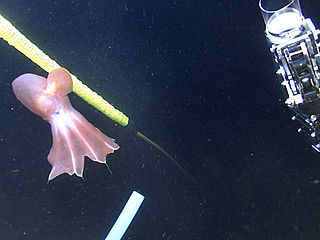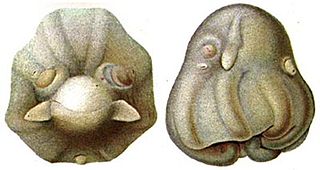
Grimpoteuthis is a genus of pelagic cirrate (finned) octopods known as the dumbo octopuses. The name "dumbo" originates from their resemblance to the title character of Disney's 1941 film Dumbo, having a prominent ear-like fin which extends from the mantle above each eye. There are 17 species recognized in the genus. Prey include crustaceans, bivalves, worms and copepods. The average life span of various Grimpoteuthis species is 3 to 5 years.

Cirrina or Cirrata is a suborder and one of the two main divisions of octopuses. Cirrate octopuses have a small, internal shell and two fins on their head, while their sister suborder Incirrina has neither. The fins of cirrate octopods are associated with a unique cartilage-like shell in a shell sac. In cross-section, the fins have distinct proximal and distal regions, both of which are covered by a thin surface sheath of muscle.

Cirroteuthis muelleri, also known as the big-finned jellyhead, was the first cirrate octopus species to be scientifically described. It is closely related to the genus Cirrothauma within the family Cirroteuthidae. At present the genus contains a single recognized species restricted to the Arctic Ocean and northern basins of the Atlantic and Pacific, but other species may be present in the southern hemisphere.

Cirrate octopuses possess a well-developed internal shell that supports their muscular swimming fins. This is in contrast to the more familiar, finless, incirrate octopuses, in which the shell remnant is either present as a pair of stylets or absent altogether.

Cirrothauma is a genus of deep water octopuses from the cirrate family Cirroteuthidae. The species Cirrothauma are fragile, gelatinous deep-sea octopods with a shell, a moderate saddle, and triangular wings. Their eyes either have lenses, as seen in the species Cirrothauma murrayi or they have reduced eyes without lenses, shown in the other extant species Cirrothauma magna. Both species were placed in Cirrothauma due to the fact that they possess similar shells. These octopuses have been reported to live in all the world's oceans, except for the Southern Ocean.

Cirrothauma murrayi, the blind cirrate octopus, is a nearly blind octopus whose eyes can sense light, but not form images. It has been found worldwide, usually 1,500 to 4,500 metres beneath the ocean's surface. Like other cirrates, it has an internal shell, muscular fins for swimming, and a web connecting the arms.
Cirroctopus hochbergi is a cirrate octopus living between 800 and 1,070 meters deep off the coast of New Zealand. The species is known from 48 specimens. It is most similar to its sister taxon, Cirroctopus mawsoni; however, C. mawsoni's ventral pigmentation is lighter, and the two species have been found in very different areas.
Grimpoteuthis boylei is a species of octopus known from only ten individuals.
Grimpoteuthis challengeri is a species of large octopus living in the abyssal zone.

Opisthoteuthis chathamensis, commonly known as the roughy umbrella octopus, is a species of cirrate octopus restricted to demersal habitats surrounding the Chatham Rise in New Zealand. It is commonly known as the roughy umbrella octopus.

Opisthoteuthis agassizii, known as the Agassiz's flapjack octopus, is a lesser-known, deep-sea octopus first described in 1883 by Addison E. Verrill.
Opisthoteuthis borealis is a lesser-known species of octopus found near Greenland and Iceland, especially in the Davis Strait. The species was described from 9 specimens, and is one of the most recent Opisthoteuthis species described. Not much is known about it besides its anatomy and habitat.
Opisthoteuthis bruuni is a species of finned cirrate octopus found along the western coast of South America. Their tissue is almost jelly-like, and they have short, round bodies.

Opisthoteuthis grimaldii is an octopus found near the Azores.
Opisthoteuths hardyi is a lesser-known octopus species. It was described in 2002 from a male caught off the Shag Rocks, which are far south in the Atlantic Ocean near the Falkland Islands.
Opisthoteuths massyae is an octopus living in the eastern Atlantic Ocean.

Opisthoteuthis medusoides is a cirrate octopus living off the coast of Tanzania near Dar es Salaam. However, its actual range may be more extensive.
Opisthoteuthis philipii is an octopus of the Indian Ocean. It lives off the coast of Kerala, India. Known specimens were found between 275–365 m (902–1,198 ft) deep in the Arabian Sea near Alappuzha.
Opisthoteuthis pluto is a deep-sea cirrate octopus found in the Great Australian Bight south of Australia. They live 270–810 m (890–2,660 ft) below the surface in the bathyal zone. Although their habitat is threatened, it is unclear how the species is affected, if at all. O. pluto is named for the Greek and Roman god of the Underworld.
Opisthoteuthis robsoni, also known as the deep-water umbrella octopus, is a deep-sea octopus living off New Zealand on the Chatham Rise. It has been found from 1,178–1,723 m (3,865–5,653 ft) below the surface. Not much is known about the octopus' habitat or life cycle, as only four specimens have been found. It occupies the benthic zone, or the seafloor and the water directly above it. O. robsoni eats large amphipods.










